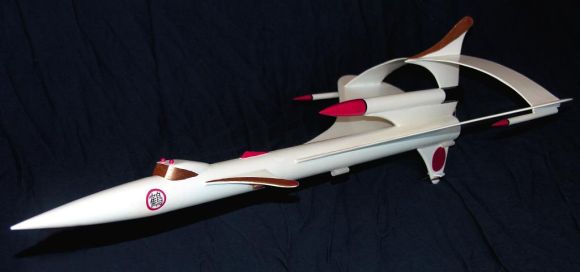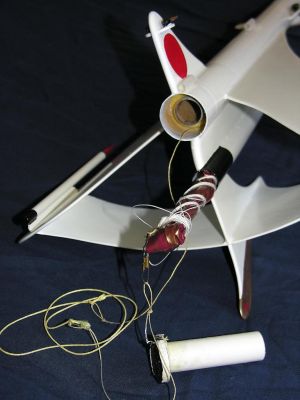| Manufacturer: | Scratch |
Brief:
The Tsuru marks the apex of 23rd century Japanese fighter craft. It was named
after the peaceful and auspicious white crane, although the sight of this bird
on your tail is enough to strike fear into the hearts of most adversaries.

This is a scratch-built fighter craft with a futuristic look and featuring rear ejection from a separate parachute pod. It's based on BT-55, is 25" tall, with 13" canted wingspan, and 7.25oz empty. It is intended for AT 18mm D RMS motors.
My goal was to design a fighter-style rocket with none of the sharp corners and angles found in most such designs. Mine is all curves. The basic design was sketched on paper one night, and then I built it by eye, modifying things as I went. The fighter has two under wing laser cannons on the downward-canted canards, two missiles under the upward-canted wings, two more laser cannons on the tail underneath, and one main missile under the arched wing canopy.
Construction:
I don't have step-by-step construction information because the build was
improvisational. Below are a few highlights.
The ejection system is an experimental separate-tube rear ejection scheme.
The nose cone is glued on. The glued-in motor mount is a telescoping tube that fits just over a standard BT-20 and is anchored in the body tube with two centering rings. The BT-20 contains the motor, and is dry fit so it can slide easily in and out. There is a block that prevents it from shooting up into the fuselage.
 Kevlar®
is tied to this BT-20 in two places. The first Kevlar®
(about 24") attaches the BT-20 to the rear centering ring. This prevents
the motor casing assembly from completely separating from the rocket. In its
packed formation, this Kevlar®
is just wound around the BT-20, so when the BT-20/motor ejects backwards this
Kevlar®
just spirals out until fully extended.
Kevlar®
is tied to this BT-20 in two places. The first Kevlar®
(about 24") attaches the BT-20 to the rear centering ring. This prevents
the motor casing assembly from completely separating from the rocket. In its
packed formation, this Kevlar®
is just wound around the BT-20, so when the BT-20/motor ejects backwards this
Kevlar®
just spirals out until fully extended.
The second Kevlar® attaches to the BT-20/motor casing and exits the rear of the rocket to sneak up into the large missile tube above the main body. This is where the chute is stored, with some additional Kevlar® and elastic length.
The idea is that the ejection charge will shoot the motor (friction fit) and its BT-20 casing out the rear of the rocket, dragging the chute out of its compartment. The chute is packed in the tube snugly enough to prevent it falling out during boost, but loosely enough to be yanked out by the ejecting motor case at apogee. Also, the two lengths of Kevlar® need to be sized appropriately so that the ejecting motor doesn't reach the "end of its rope" before fully yanking out the chute!
The plan was that the resulting nose-first descent would help protect the elaborate tail assemblies during landing.
 I used virtually
every tube in the book from BT-55 downward, including some cool micro tubes for
small missiles, with tiny balsa nose cones. Fins, canards, etc. were improvised
as I went, following the spirit of my original sketch. The arched canopy was
cut from a cardboard oatmeal container and wallpapered with card stock and
white glue. The cockpit was hand-carved from balsa. The various laser mounts,
lights, etc. were pirated from my daughter's necklace bead kit.
I used virtually
every tube in the book from BT-55 downward, including some cool micro tubes for
small missiles, with tiny balsa nose cones. Fins, canards, etc. were improvised
as I went, following the spirit of my original sketch. The arched canopy was
cut from a cardboard oatmeal container and wallpapered with card stock and
white glue. The cockpit was hand-carved from balsa. The various laser mounts,
lights, etc. were pirated from my daughter's necklace bead kit.
Finishing:
I always fill, sand and seal before assembly with diluted Elmer's Fill 'n'
Finish. The canards also got a first coat of CA for extra strength. Rustoleum
white spray paint was used over gray primer. The black parts were brush painted
with Testors gloss black and scotch tape masks. The red and gold portions were
painted freehand, again with Testors. The Japanese "tsuru" kanji
symbol was downloaded from the web, spruced up in Adobe Illustrator, printed on
plain white paper, and glued in place with spray adhesive. Wal-Mart clear gloss
went over everything. Finally, I remembered to glue on the darn launch lugs!
Flight:
Swing tests were fine except that after twirling around in the backyard I was
ready to lose my lunch the rest of the day. Despite the apparent stability, I
was worried about performance at high speed and possible flutter in the arched
wing canopy. Then of course, there was also a high probability of lawn-darting,
given the experimental rear ejection system.
The chute and lines went into the missile tube, with a half-sheet of crumpled wadding stuffed in the end to prevent spilling during ascent. First launch was on a AT D13-4 RMS. There was a stiff cold wind blowing at about 10mph.
Boost was the coolest and least rocket-like I've ever seen. Straight off the rod, the rocket arced firmly into horizontal flight downwind at about 400 feet altitude. There was definitely no flutter. It was difficult to be sure while watching from below, but I swear that Tsuru was gaining altitude in a modest ascent with horizontal body position, just like an airplane would. This smooth, stable ascending horizontal flight occurred during boost and during the coast phase. Near the end of the coast, you could even sense that the wing canting was providing extra side-to-side stability.
Recovery:
Because Tsuru was performing more like a glider than a rocket at this speed,
there was little deceleration and no apogee after the motor delay--the chute
popped at nearly full speed, ripping most of the shroud lines out of the
24" chute. The good news is that the rear ejection system worked
perfectly. The bad news is that recovery continued via glorified streamer. Upon
nose-first impact, the arched canopy separated from the missile/parachute tube,
and its downward momentum split both wings lengthwise along the grain, but not
all the way to the body tube. The nose cone also looks more like a Concorde jet
now.
Despite the shroud line problem, I'm thrilled with the jet-like flight pattern and the totally successful rear-ejection system. Tsuru will be back, I promise! The D13 was plenty of power, but next time I'll opt for an extra long delay and heavy-duty chute construction.
Sponsored Ads
 |
 |











